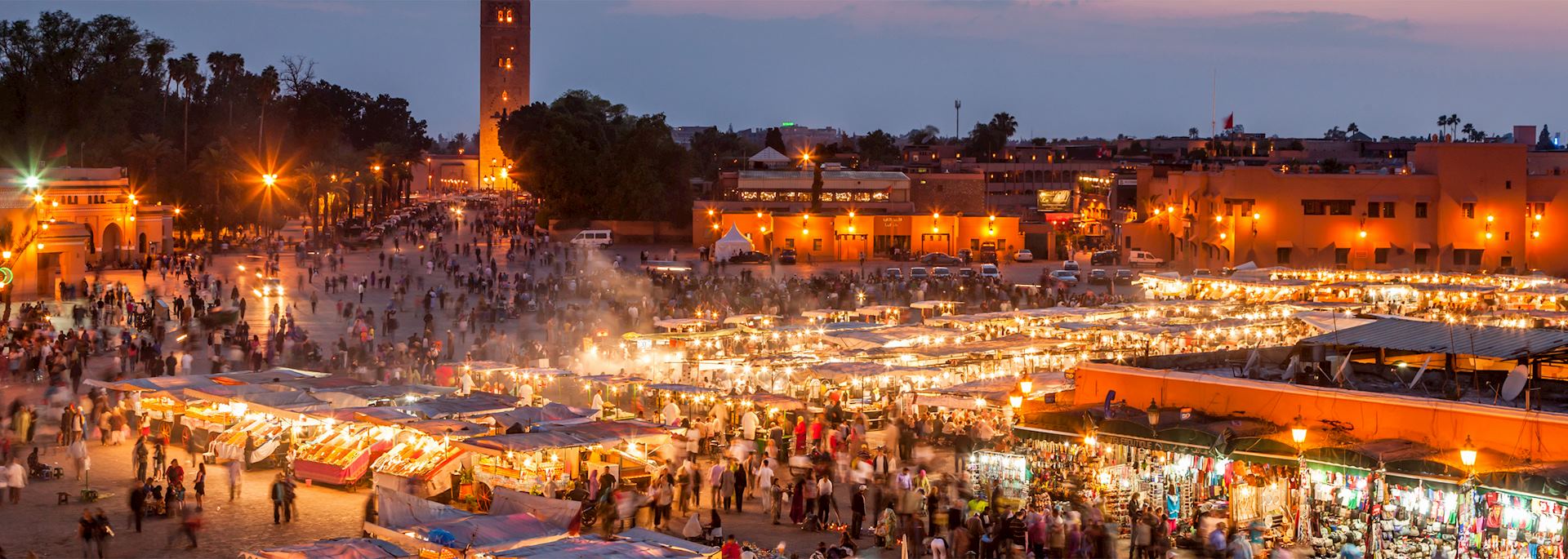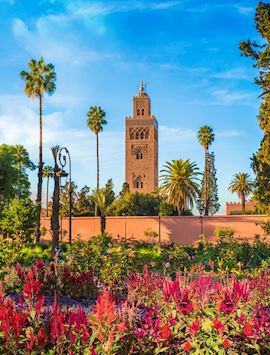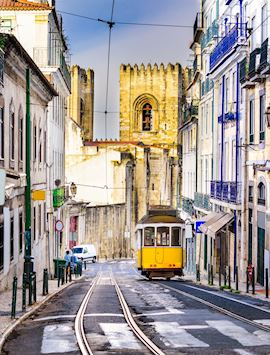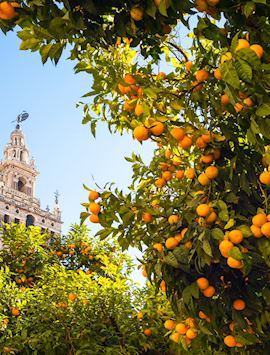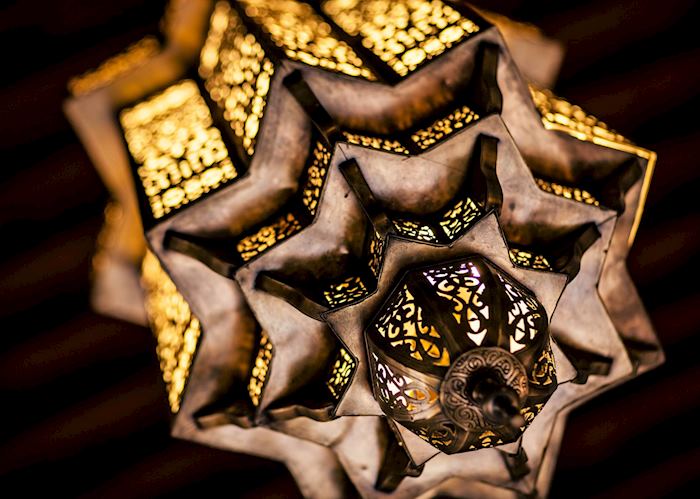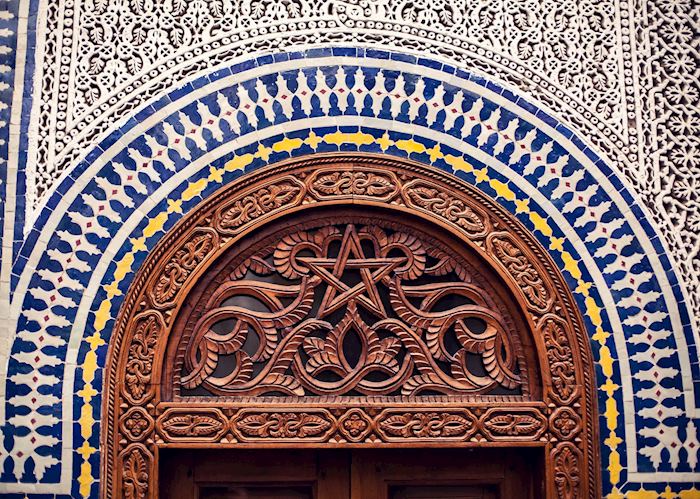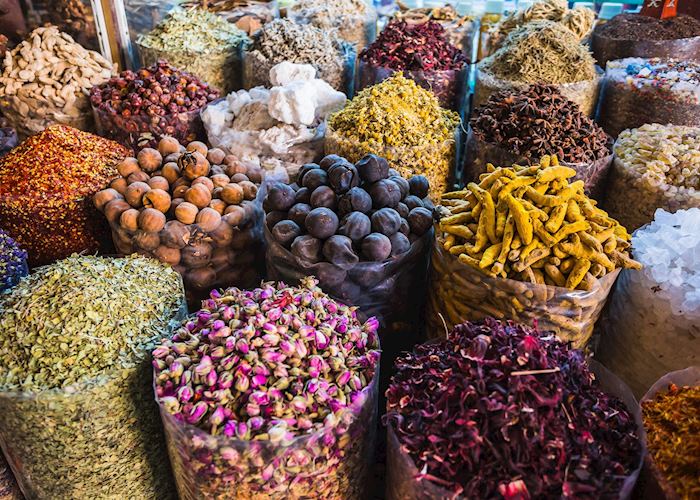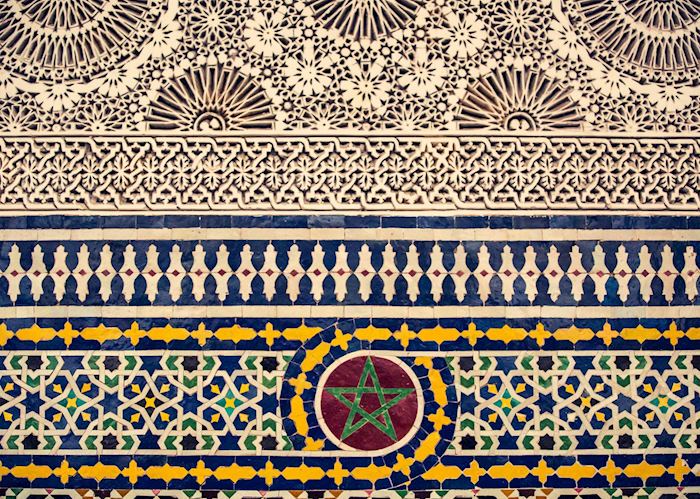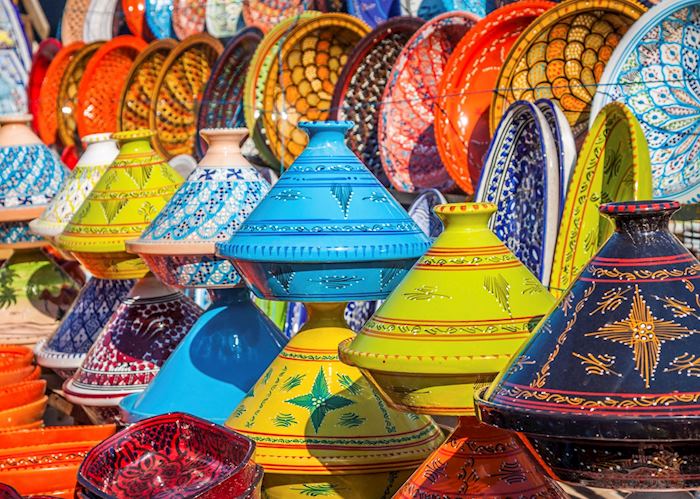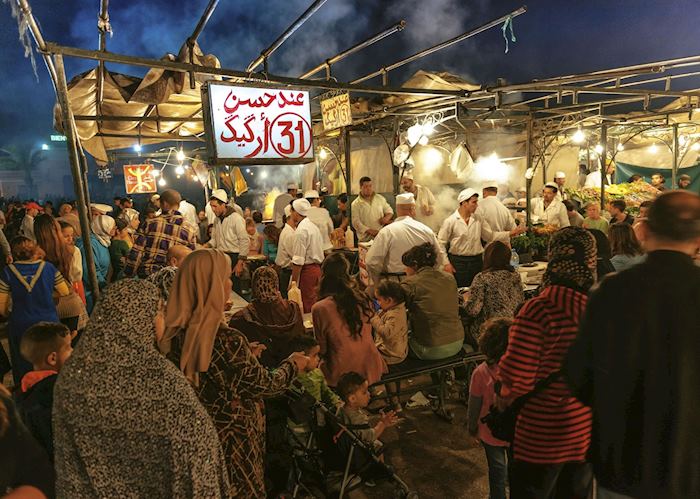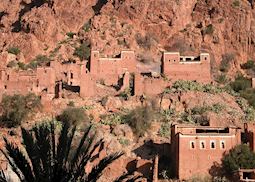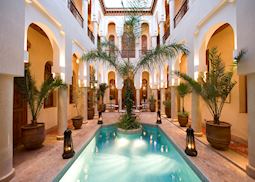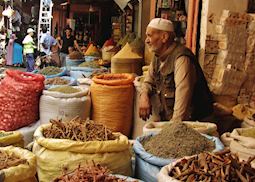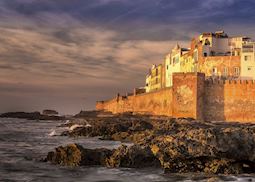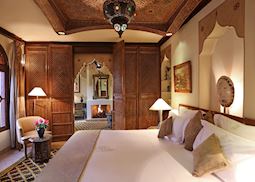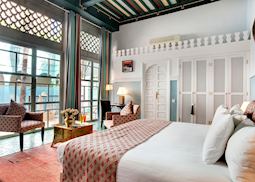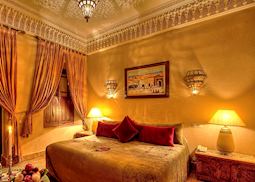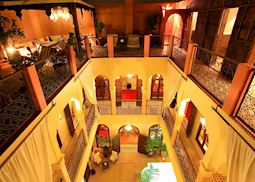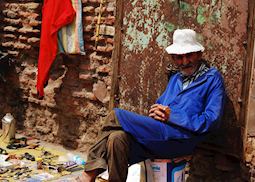Jump to:
Marrakesh, with its lattice of souqs, intricate Moorish architecture and ancient streets humming with people, donkeys, mopeds and mules, is a city with many layers to explore. Mosques and palaces that have stood for centuries focus your attention on the city’s changeable past. The carnival atmosphere of the main public square Djemaa El Fna fizzes with life as snake charmers and dancers perform for the crowds.
A trip to Marrakesh can present many different experiences, from cookery classes and tasting trails to peaceful garden strolls or a rejuvenating bathe in a hammam. All combine to leave you with a tantalising taste of North African culture.
Morocco specialist JuneMarrakesh doesn't give itself up to visitors easily, but I recommend getting a little lost in the souqs — soon you’ll realise that the medina is all about the small things: the pyramids of vibrant spices, the scent of Moroccan leather and the perfume of orange blossom.
Things to see and do in Marrakesh
See artisans at work in the souqs
The maze-like souqs are often what draws people to Marrakesh. Thousands of stallholders sell anything from cactus silk scarves to aromatic herbs and Arabian-style lamps.
Seeing what goes on behind the scenes in the souqs leaves you with a greater appreciation for the goods you barter for. A guide can lead you through the back alleys, where the air rings with the sounds of carpenters, metalworkers, fabric dyers and cobblers working hard on their craft. Each quarter of the souqs focuses on a separate trade, so a tour like this gives you a real sense of the overall picture.
Join a women's cooperative cookery course
The Amal Association in Gueliz, Marrakesh’s new town, provides disadvantaged women aged 18 to 40 with six months of training in cookery and waitressing, helping them to become financially independent. The association has its own restaurant so students can practise their new skills on paying guests, and it also runs cookery courses for the public.
During the cookery course, which caters for up to ten people, you’ll learn how to make one type of tagine — Morocco’s signature dish of meat or vegetables slowly boiled in a broth. Your host will explain how to use the spices and herbs found in Moroccan cooking, and you’ll cook your tagine in a traditional conical clay pot. You’ll then sit down to eat your creation with the rest of the group.
Visit the Saadian Tombs
Built in the late 16th century under the rule of Sultan Ahmad al-Mansur, the Saadian Tombs were lost in time until their rediscovery in 1917. The tombs contain nearly 200 members of the Saadi Dynasty, who ruled Morocco in the 1500s and 1600s, including the sultan and his family. They lie in exquisitely decorated mausoleums featuring mosaics, patterned stucco and intricately carved cedar wood. Scattered around the grounds are the more modest graves of the family’s servants and soldiers.
Strolling around this peaceful area of Marrakesh while admiring the architecture brings you closer to this era of the city’s past and understanding how death was viewed at this time.
Soak up the festival atmosphere in Djemaa El Fna
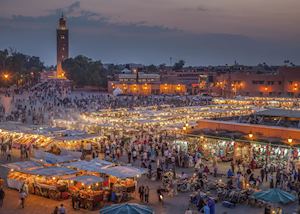 Djemaa El Fna has provided a focal point in the city since its founding in the 11th century. Flanked by the Djemaa El Fna souq and overlooked by the Koutoubia Mosque — the largest in Marrakesh at 77 m (253 ft) high — the square was once a place where public hangings took place.
Djemaa El Fna has provided a focal point in the city since its founding in the 11th century. Flanked by the Djemaa El Fna souq and overlooked by the Koutoubia Mosque — the largest in Marrakesh at 77 m (253 ft) high — the square was once a place where public hangings took place.
These days, musicians, acrobats, fortune-tellers and snake charmers occupy the open space, drawing crowds of both local people and visitors and creating a lively, uplifting atmosphere. The square really comes to life in the evening, when open-air restaurants sizzle and smoke and the smell of grilled meats and spices fills the air.
Take a tasting trail around the medina
Marrakesh has a very food-centric culture. During your travels, you’re sure to encounter some of the many sweet pastries used to welcome guests, while mint tea will be a staple of your diet.
A good way to sample the wide range of food on offer is to take a guided tasting trail through the city’s medina (the fortified, oldest section of the city). Here, street food stalls cook a variety of dishes in front of you, including more adventurous options like steamed sheep heads and snail soup. Bread is freshly baked for you in communal ovens and stalls are piled high with brown, green and yellow olives. At the end of the trail, you’ll dine on a local meal in a restaurant overlooking Djemaa El Fna.
Stroll around the Majorelle Garden
A tranquil retreat from Marrakesh’s chaotic streets, Jardin Majorelle was lovingly created by French painter Jacques Majorelle over the space of 40 years, opening to the public in 1947. It feels like another world as you stroll along the shady paths lined with exotic plants, palm trees, bamboo and cacti, passing flowing streams and ponds.
More recently, the garden was owned by French fashion designer Yves Saint Laurent until his death in 2008. You can now browse his ‘Galerie Love’ art gallery in the grounds. There’s also a boutique, a café and the Musée Berbère Jardin Majorelle containing over 600 artefacts collected from indigenous tribes living in the Atlas Mountains and the Sahara. Exhibits include clothing, jewellery, tools and textiles.
Discover the history of El Badi Palace
With a name meaning ‘The Incomparable’, El Badi Palace’s size and grandeur would have been a sight to behold upon its completion in the late 16th century. The palace was commissioned by the Saadian sultan Ahmad al-Mansur and took the best craftsmen of the time around 25 years to build using materials such as gold, onyx and marble.
Now in ruins, it’s still easy to imagine how impressive it would have looked due to the scale of the site — you can even see evidence of the underground heating system that was in use. There’s also an onsite museum that explores the palace’s history.
Visit La Maison de la Photographie
If you’re interested in photography and the history and culture of Morocco, La Maison de la Photographie is certainly worth an hour or two of your time. The gallery has a collection of more than 4,500 original photographs taken by visitors to Morocco or professional photographers between 1870 and 1960, as well as historical documents, postcards, maps and video documentaries.
The collection depicts the country’s diverse population, featuring insightful images of indigenous tribe members, Moroccan Arabs and Jews, and general daily life around Morocco at this time. The gallery also has a rooftop cafe where you can enjoy a drink or snack while gazing out over the city.
Relax in a hammam
Visiting a hammam is an age-old tradition as well as an important part of life for modern Moroccans, who attend at least once a week to clean themselves and catch up on local gossip. The hammam ritual involves spending time in one of the steam rooms to cleanse your skin before covering your body in savon noir (a black soap made of olive oil). You then scrub yourself with an exfoliating mitt to remove dead skin and dirt, before rinsing off using a bucket of water.
Visiting a public hammam is a great way to join in this aspect of local Moroccan life, but many hotels and riads feature their own hammams if you’d prefer a more private experience. Here, staff conduct the ritual for you.
Festivals, events and seasonal reasons to visit
- The International Film Festival (December) is held annually in Marrakesh to promote and celebrate all forms of cinema. The festival was established in 2001 by King Mohammed VI.
- The month of Ramadan can sometimes disrupt your daily routine, but if you’re fascinated by different cultures and religions it’s an exciting time to visit. The breaking of the fast at sundown is an electric experience as communities and families often meet up to eat together.
Best time to visit Marrakesh
Spring (April to May) and autumn (September to October) are generally the best times to visit Marrakesh. At this time the weather is usually sunny and pleasantly warm, unlike the scorching heat of the Moroccan summer or the cooler winter months.
who's been there
-
01993 838 92501993 838 420
- Make an enquiry
Suggested itineraries featuring Marrakesh
Our itineraries will give you suggestions for what is possible when you travel in Marrakesh, and they showcase routes we know work particularly well. Treat them as inspiration, because your trip will be created uniquely by one of our specialists.
Places near Marrakesh
- Ourika Valley 34 miles away
- The Atlas Mountains 35 miles away
- Oued Mellah 60 miles away
- Ouarzazate 80 miles away
- Skoura 93 miles away
- The Southern Oases Valleys 96 miles away
- Taroudant 96 miles away
- Essaouira 106 miles away
- The Dades Valley 119 miles away
- Casablanca 138 miles away
- The Draa Valley 142 miles away
- The Souss-Massa National Park 142 miles away
- Zagora 156 miles away
- Rabat 179 miles away
- The Anti Atlas 191 miles away
- Meknes & Volubilis 211 miles away
- The Erg Chebbi 240 miles away
- Fez 243 miles away
- Asilah 289 miles away
- Chefchaouen 291 miles away
Photos of Marrakesh
Our expert guides to exploring Marrakesh
Written by our specialists from their own experiences of visiting Marrakesh, these guides will help you make the most of your time there. We share both our practical recommendations and the best ways to appreciate Marrakesh at its best.
-
Family holidays in Morocco ![Berber village in Ameln Valley, The Anti Atlas, Morocco]()
Family holidays in Morocco
Family holidays in Morocco
A vibrant and diverse country, Morocco is a very family-friendly destination with plenty of hands-on experiences and quirky accommodation options for families. Morocco specialist Kerry explains how to get the most out of your time here.
Read this guide -
Riads and kasbahs of Morocco ![Riad Lydines, Marrakesh]()
Riads and kasbahs of Morocco
Riads and kasbahs of Morocco
A stay in a riad or kasbah offers intimacy, style, character and charm, and is undoubtedly a highlight of any trip to Morocco. Here at Audley we can recommend traditional accommodation to suit your preferences.
Read this guide -
Your guide to the souqs of Morocco ![Marrakesh souq]()
Your guide to the souqs of Morocco
Your guide to the souqs of Morocco
The souqs of Morocco overflow with wares, including pierced lanterns, hand tied rugs and brightly dyed leather goods. Discover what you can expect and how to haggle for a rug with our insider’s guide to these vibrant markets.
Read this guide -
Morocco food experiences ![Moroccan cuisine]()
Morocco food experiences
Morocco food experiences
Influenced over the centuries by numerous cultures, Moroccan cuisine is renowned for its delicious taste. We recommend dishes you should try and places to eat to help you make the most of your Moroccan food experience.
Read this guide -
Honeymoons in Morocco ![The Erg Chebbi, Morocco]()
Honeymoons in Morocco
Honeymoons in Morocco
Plan your perfect honeymoon to Morocco. Country specialist, Kerry, picks some of the country’s highlights, from exploring Marrakesh, Fez and the High Atlas Mountains to getting off the beaten track in the Sahara Desert and the town of Skoura with its collection of kasbahs.
Read this guide -
What to do in Morocco: our highlights guide ![Essaouira, Morocco]()
What to do in Morocco: our highlights guide
What to do in Morocco: our highlights guide
Morocco is a destination with fascinating local customs, a rich history and many geological wonders. Immerse yourself in the labyrinth of Medieval souqs, try the local cuisine, go walking in the beautiful High Atlas Mountains, or take a camel trip into the desert and sleep under the stars.
Read this guide
Accommodation choices for Marrakesh
We've selected a range of accommodation options for when you visit Marrakesh. Our choices usually come recommended for their character, facilities and service or location. Our specialists always aim to suggest properties that match your preferences.
-
![Villa Des Orangers, Marrakesh]()
Villa des Orangers
Marrakesh -
![Les Borjs de la Kasbah courtyard]()
Les Borjs de la Kasbah
Marrakesh -
![Suite, La Maison Arabe, Marrakesh]()
La Maison Arabe
Marrakesh -
![Suite, Les Jardins De La Medina, Marrakesh]()
Les Jardins de la Medina
Marrakesh -
![Deluxe villa with private pool, The Oberoi Marrakesh]()
The Oberoi Marrakesh
Marrakesh -
![Deluxe room, Riad Kniza, Marrakesh]()
Riad Kniza
Marrakesh -
![Suite, Palais Khum Marrakech, Marrakesh]()
Riad Palais Khum
Marrakesh -
![Riad Djemanna, Marrakesh]()
Riad Djemanna
Marrakesh -
![Deluxe suite, La Sultana, Marrakesh]()
La Sultana Marrakesh
Marrakesh -
![Riad Ilyaka, Marrakesh]()
Riad Ilayka
Marrakesh -
![Royal Mansour, Marrakesh]()
Royal Mansour Marrakesh
Marrakesh
Ideas for experiencing Marrakesh
Our specialists seek out authentic ways to get to know the places that could feature in your trip. These activities reflect some of the experiences they've most enjoyed while visiting Marrakesh, and which use the best local guides.
-
Photographic tour of Marrakesh ![Craftsman, Marrakesh]()
Photographic tour of Marrakesh
Photographic tour of Marrakesh
Pick up your camera for this half-day tour that takes in the workshops of Marrakesh’s artisans, medieval inns and Museum of Photography.
View details -
Day trip to Kasbah du Toubkal ![Kasbah du Toubkal]()
Day trip to Kasbah du Toubkal
Day trip to Kasbah du Toubkal
Head to Kasbah du Toubkal in the High Atlas Mountains for a day of relaxation, mule rides, walks and traditional hammams.
View details -
Essaouira village visit ![Essaouira, Morocco]()
Essaouira village visit
Essaouira village visit
Visit an ancient Portuguese fortress that dates from the 18th century (formerly called Mogador) and one of the most attractive towns along Morocco’s Atlantic coast.
View details -
Amazigh village & Assafou Foundation visit ![Amazigh hospitality in the High Atlas]()
Amazigh village & Assafou Foundation visit
Amazigh village & Assafou Foundation visit
Head into the High Atlas Mountains to meet and have a traditional lunch with an Amazigh family before visiting the Assafou Foundation, a charity that supports local children, women and older men who want to further their education.
View details -
Guided excursion to the Gardens of Marrakesh ![Majorelle Gardens, Marrakesh]()
Guided excursion to the Gardens of Marrakesh
Guided excursion to the Gardens of Marrakesh
The gardens of Marrakesh are as famous as the medina itself and with or without a particular interest in gardening you will be sure to enjoy time spent in these beautiful retreats.
View details -
Aït Benhaddou & Telouet tour ![Ait Benhaddou, Morocco]()
Aït Benhaddou & Telouet tour
Aït Benhaddou & Telouet tour
Visit two of Morocco's most famous kasbahs, Aït Benhaddou and Telouet, on a tour through the country's stunning Ouarzazate Valley.
View details -
Marrakesh city tour ![Marrakesh, Morocco]()
Marrakesh city tour
Marrakesh city tour
In the morning you visit the historical sights, including the Saadian Tombs, the Koutoubia Mosque, and the El Badi Palace. In the afternoon you focus on the arts and crafts of the city visiting the souqs and concluding at the Djemaa El Fna.
View details -
Cookery course at La Maison Arabe ![Traditional tajine, Morocco]()
Cookery course at La Maison Arabe
Cookery course at La Maison Arabe
La Maison Arabe in Marrakesh offers cooking workshops designed for anyone who wishes to discover the pleasures of Moroccan cooking.
View details -
Marrakesh tasting trail ![Orange seller in Marrakesh, Morocco]()
Marrakesh tasting trail
Marrakesh tasting trail
Experience the tastes and smells of Moroccan cuisine with this tour that will take you through the culinary delights of Marrakesh’s Djemaa El Fna and its surrounding souqs.
View details

